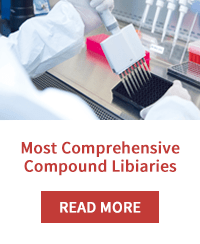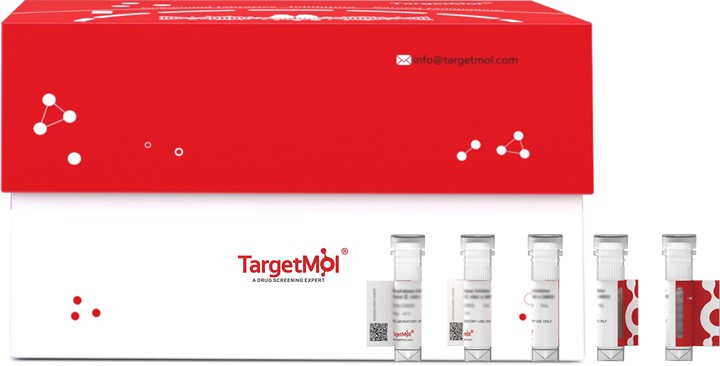

PDGF-C is a member of the PDGF/VEGF family of growth factors with a unique domain organization and expression pattern. Platelet-derived growth factor receptors (PDGFRs) are catalytic receptors that have intracellular tyrosine kinase activity. They have roles in the regulation of many biological processes including embryonic development, angiogenesis, cell proliferation and differentiation, and contribute to the pathophysiology of some diseases, including cancer. There are two isoforms of the PDGFR receptor; PDGFRalpha and PDGFRbeta, which can form homo- or heterodimers. The endogenous PDGFR ligands are PDGF-A, -B, -C and -D, which induce receptor dimerization and transphosphorylation at specific tyrosine residues upon binding. This activates the intracellular kinase activity, initiating intracellular signaling through the MAPK, PI 3-K and PKCgamma pathways. PDGF-C acts as a specific ligand for alpha platelet-derived growth factor receptor homodimer, and alpha and beta heterodimer. Binding of this growth factor to its affinity receptor elicits a variety of cellular responses. PDGF-C appears to be involved in the three stages of wound healing: inflammation, proliferation and remodeling. PDGF-C is involved in fibrotic processes, in which transformation of interstitial fibroblasts into myofibroblasts plus collagen deposition occurs.

| Pack Size | Availability | Price/USD | Quantity |
|---|---|---|---|
| 100 μg | 5 days | $ 618.00 |
| Description | PDGF-C is a member of the PDGF/VEGF family of growth factors with a unique domain organization and expression pattern. Platelet-derived growth factor receptors (PDGFRs) are catalytic receptors that have intracellular tyrosine kinase activity. They have roles in the regulation of many biological processes including embryonic development, angiogenesis, cell proliferation and differentiation, and contribute to the pathophysiology of some diseases, including cancer. There are two isoforms of the PDGFR receptor; PDGFRalpha and PDGFRbeta, which can form homo- or heterodimers. The endogenous PDGFR ligands are PDGF-A, -B, -C and -D, which induce receptor dimerization and transphosphorylation at specific tyrosine residues upon binding. This activates the intracellular kinase activity, initiating intracellular signaling through the MAPK, PI 3-K and PKCgamma pathways. PDGF-C acts as a specific ligand for alpha platelet-derived growth factor receptor homodimer, and alpha and beta heterodimer. Binding of this growth factor to its affinity receptor elicits a variety of cellular responses. PDGF-C appears to be involved in the three stages of wound healing: inflammation, proliferation and remodeling. PDGF-C is involved in fibrotic processes, in which transformation of interstitial fibroblasts into myofibroblasts plus collagen deposition occurs. |
| Species | Cynomolgus |
| Expression System | HEK293 |
| Tag | hFc |
| Accession Number | G7P6G9 |
| Synonyms | platelet derived growth factor C |
| Construction | A DNA sequence encoding the cynomolgus PDGFC (EHH54037.1) (Val235-Gly345) was expressed with the Fc region of human IgG1 at the N-terminus. |
| Protein Purity | > 90 % as determined by SDS-PAGE |
| Molecular Weight | Approxiamtely 40.9 kDa |
| Endotoxin | < 1.0 EU per μg protein as determined by the LAL method. |
| Formulation | Lyophilized from sterile PBS, pH 7.4. Please contact us for any concerns or special requirements. Normally 5 % - 8 % trehalose, mannitol and 0. 01% Tween 80 are added as protectants before lyophilization. Please refer to the specific buffer information in the hard copy of CoA. |
| Reconstitution | A hardcopy of datasheet with reconstitution instructions is sent along with the products. Please refer to it for detailed information. |
| Stability & Storage |
Samples are stable for up to twelve months from date of receipt at -20℃ to -80℃. Store it under sterile conditions at -20℃ to -80℃. It is recommended that the protein be aliquoted for optimal storage. Avoid repeated freeze-thaw cycles. |
| Shipping |
In general, recombinant proteins are provided as lyophilized powder which are shipped at ambient temperature.Bulk packages of recombinant proteins are provided as frozen liquid. They are shipped out with blue ice unless customers require otherwise. |
| Research Background | PDGF-C is a member of the PDGF/VEGF family of growth factors with a unique domain organization and expression pattern. Platelet-derived growth factor receptors (PDGFRs) are catalytic receptors that have intracellular tyrosine kinase activity. They have roles in the regulation of many biological processes including embryonic development, angiogenesis, cell proliferation and differentiation, and contribute to the pathophysiology of some diseases, including cancer. There are two isoforms of the PDGFR receptor; PDGFRalpha and PDGFRbeta, which can form homo- or heterodimers. The endogenous PDGFR ligands are PDGF-A, -B, -C and -D, which induce receptor dimerization and transphosphorylation at specific tyrosine residues upon binding. This activates the intracellular kinase activity, initiating intracellular signaling through the MAPK, PI 3-K and PKCgamma pathways. PDGF-C acts as a specific ligand for alpha platelet-derived growth factor receptor homodimer, and alpha and beta heterodimer. Binding of this growth factor to its affinity receptor elicits a variety of cellular responses. PDGF-C appears to be involved in the three stages of wound healing: inflammation, proliferation and remodeling. PDGF-C is involved in fibrotic processes, in which transformation of interstitial fibroblasts into myofibroblasts plus collagen deposition occurs. |
bottom
Please read the User Guide of Recombinant Proteins for more specific information.
PDGFC Protein, Cynomolgus, Recombinant (hFc) platelet derived growth factor C recombinant recombinant-proteins proteins protein
